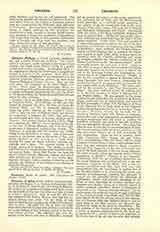

Caesarea Philippi, a Greek Catholic residential see, and a Latin titular see, in Syria. The native name is unknown; under Antiochus the Great it bore already the Greek name Panion owing to a grotto consecrated to Pan’s worship. It was given (20 E. c.) by Augustus to Herod, who built there a magnificent temple in honor of the emperor. Soon after, the tetrarch Philip embellished it and dedicated it to his imperial protector Tiberius, whence its new name Caesarea Philippi or Caesarea Paneas. Near this city took place the confession of St. Peter (Matt., xvi, 13-20). There lived the Haemorrhozssa (Matt., ix, 20); according to Eusebius she set up before her house a bronze monument representing her cure by Jesus; in this group Julian the Apostate substituted his own statue for that of Christ.
Caesarea was at an early date a suffragan of Tyre in Phoenicia Prima. Five bishops (to 451) are mentioned by Lequien (II, 831), the first of whom, St. Erastus (Rom., xvi, 23), is obviously legendary. After the town’s capture by the crusaders (about 1132) a Latin see was established there; four titulars are mentioned in Lequien (II, 1337); they must not be confounded with those of Panium, another see in Thracia. The modern name is Banias, a little village on a pleasing site, 990 feet above the level of the sea, at the foot of Mount Hermon, and forty-five miles southwest of Damascus, capital of the vilayet. The landscape is splendid, and the country very fertile, owing to the abundance of water. One of the main sources of the Jordan rises in the grotto of Pan, now partly blocked up and serving as a cattle shed. Among the ruins are many columns, capitals, sarcophagi, and a gate. The ancient church of St. George serves as a mosque. The citadel is partly preserved and is considered the most beautiful medieval ruin in Syria. Since 1886 Banias has been the see of a Greek Catholic (Melchite) bishop, with about 4000 faithful and 20 priests. Its first titular, Monseigneur Geralgiry, built a number of churches and 26 schools; the residence of the bishop is near Banias at Gedaidat-Margyoum.
S. VAILHE

